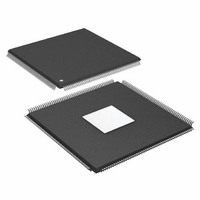ADSP-21371KSWZ-2B Analog Devices Inc, ADSP-21371KSWZ-2B Datasheet - Page 11

ADSP-21371KSWZ-2B
Manufacturer Part Number
ADSP-21371KSWZ-2B
Description
IC DSP 32BIT 266MHZ 208-LQFP
Manufacturer
Analog Devices Inc
Series
SHARC®r
Type
Floating Pointr
Specifications of ADSP-21371KSWZ-2B
Package / Case
208-LQFP
Interface
DAI, DPI
Operating Temperature
0°C ~ 70°C
Clock Rate
266MHz
Non-volatile Memory
ROM (512 kB)
On-chip Ram
128kB
Voltage - I/o
3.30V
Voltage - Core
1.20V
Mounting Type
Surface Mount
Svhc
No SVHC (18-Jun-2010)
Base Number
21371
Core Frequency Typ
266MHz
Dsp Type
Floating Point
Mmac
532
No. Of Pins
208
Interface Type
SPI, UART
Rohs Compliant
Yes
Operating Temperature Range
0°C To +70°C
Lead Free Status / RoHS Status
Lead free / RoHS Compliant
Available stocks
Company
Part Number
Manufacturer
Quantity
Price
Company:
Part Number:
ADSP-21371KSWZ-2B
Manufacturer:
Analog Devices Inc
Quantity:
10 000
Part Number:
ADSP-21371KSWZ-2B
Manufacturer:
ADI/亚德诺
Quantity:
20 000
Delay Line DMA
The processors provide delay line DMA functionality. This
allows processor reads and writes to external delay line buffers
(and hence to external memory) with limited core interaction.
Scatter/Gather DMA
The ADSP-2137x processor provides scatter/gather DMA func-
tionality. This allows processor DMA reads/writes to/from non-
contiguous memory blocks.
SYSTEM DESIGN
The following sections provide an introduction to system design
options and power supply issues. For complete system design
information, see the ADSP-2137x SHARC Processor Hardware
Reference.
Program Booting
The internal memory of the processor boots at system power-up
from an 8-bit EPROM via the external port, an SPI master, or an
SPI slave. Booting is determined by the boot configuration
(BOOT_CFG1–0) pins in
is controlled via the SPI as either a master or slave device, or it
can immediately begin executing from ROM.
Table 8. Boot Mode Selection
The “Running Reset” feature allows programs to perform a reset
of the processor core and peripherals, but without resetting the
PLL and SDRAM controller, or performing a boot. The
RESETOUT pin acts as the input for initiating a running reset.
Power Supplies
The processors have separate power supply connections for the
internal (V
internal supplies must meet the 1.2 V requirement. The external
supply must meet the 3.3 V requirement. All external supply
pins must be connected to the same power supply.
Target Board JTAG Emulator Connector
Analog Devices DSP Tools product line of JTAG emulators uses
the IEEE 1149.1 JTAG test access port of the processor to moni-
tor and control the target board processor during emulation.
Analog Devices DSP Tools product line of JTAG emulators pro-
vides emulation at full processor speed, allowing inspection and
modification of memory, registers, and processor stacks. The
processor’s JTAG interface ensures that the emulator will not
affect target system loading
or timing.
For complete information on Analog Devices’ SHARC DSP
Tools product line of JTAG emulator operation, see the appro-
priate “Emulator Hardware User’s Guide”.
BOOT_CFG1–0
00
01
10
11
DDINT
), and external (V
Booting Mode
SPI Slave Boot
SPI Master Boot
EPROM/FLASH Boot
Reserved
Table
8. Selection of the boot source
DDEXT
) power supplies. The
Rev. C | Page 11 of 52 | September 2009
DEVELOPMENT TOOLS
The processors are supported with a complete set of
CROSSCORE
including Analog Devices emulators and VisualDSP++
opment environment. The same emulator hardware that
supports other SHARC processors also fully emulates the
ADSP-21371/ADSP-21375.
The VisualDSP++ project management environment lets pro-
grammers develop and debug an application. This environment
includes an easy to use assembler (which is based on an alge-
braic syntax), an archiver (librarian/library builder), a linker, a
loader, a cycle-accurate instruction-level simulator, a C/C++
compiler, and a C/C++ runtime library that includes DSP and
mathematical functions. A key point for these tools is C/C++
code efficiency. The compiler has been developed for efficient
translation of C/C++ code to DSP assembly. The SHARC pro-
cessor has architectural features that improve the efficiency of
compiled C/C++ code.
The VisualDSP++ debugger has a number of important fea-
tures. Data visualization is enhanced by a plotting package that
offers a significant level of flexibility. This graphical representa-
tion of user data enables the programmer to quickly determine
the performance of an algorithm. As algorithms grow in com-
plexity, this capability can have increasing significance on the
designer’s development schedule, increasing productivity. Sta-
tistical profiling enables the programmer to nonintrusively poll
the processor as it is running the program. This feature, unique
to VisualDSP++, enables the software developer to passively
gather important code execution metrics without interrupting
the real-time characteristics of the program. Essentially, the
developer can identify bottlenecks in software quickly and effi-
ciently. By using the profiler, the programmer can focus on
those areas in the program that impact performance and take
corrective action.
Debugging both C/C++ and assembly programs with the
VisualDSP++ debugger, programmers can
The VisualDSP++ IDDE lets programmers define and manage
DSP software development. Its dialog boxes and property pages
let programmers configure and manage all of the SHARC devel-
opment tools, including the color syntax highlighting in the
VisualDSP++ editor. This capability permits programmers to:
• View mixed C/C++ and assembly code (interleaved source
• Insert breakpoints
• Set conditional breakpoints on registers, memory,
• Perform linear or statistical profiling of program execution
• Fill, dump, and graphically plot the contents of memory
• Perform source level debugging
• Create custom debugger windows
• Control how the development tools process inputs and
and object information)
and stacks
generate outputs
®
software and hardware development tools,
ADSP-21371/ADSP-21375
®
devel-













